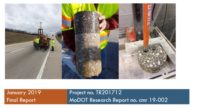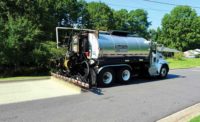Asphalt additives called rejuvenators show potential for facilitating higher proportions of recycled asphalt pavement in road mixes. Two private companies, Cargill and Hardrives, have been testing a plant-based product, Anova, in a partnership with the Minnesota Dept. of Transportation and its MnROAD test facility and with the National Center for Asphalt Technology at Auburn University in Alabama.
Launched in 2018, the tests include a section of Interstate 94 in Minnesota. The asphalt mix included 45% recycled asphalt pavement (RAP), says Ben Worel, MnROAD research operations engineer for MnDOT. The typical ratio of RAP would be about 25%. “A year and a half later, we’ve not seen any difference between the controlled sections and Anova section,” he says.
Susan Listberger, Cargill global product line manager, says Anova is basically a vegetable oil developed in a specialty plant. A metered dose is pumped directly into the asphalt. “This is not a new product,” she notes. “The purpose of these tests is to provide industry confidence regarding rejuvenation technology.”
Hassan Tabatabaee, Cargill’s global technical manager for asphalt business, says the partnership with MnDOT and the National Center for Asphalt Technology (NCAT) includes developing specs and performance measures to guide the use of rejuvenators and high-content RAP mixes for each state DOT.
Rejuvenators are bio-based additives derived from agricultural raw materials. “It’s designed to rebalance and replenish chemical aspects of asphalt lost due to aging,” Tabatabaee says. “If you take an old road and mill it up and incorporate it into new pavement as RAP untreated, it will carry over some of that deterioration into the new pavement. That’s where a rejuvenator comes in. It’s specifically engineered to treat and rebalance old asphalt.”
The aim is to increase performance life and make pavements more sustainable with higher use of recycled products and also to anticipate depleted supply of aggregates from quarries.
Worel says the test section will be monitored over the next three years. He adds that MnDOT has tested various rejuvenators besides Anova, including soy-based and corn-based products, as part of the National Road Research Alliance, a pooled effort including eight other DOTs and tollway agencies.
Kim Tolzmann, regional QC manager for Minnesota Paving & Materials—the contractor for the MnDOT test section —says the treated asphalt acted much the same as regular asphalt. “We saw no significant changes in elementary properties. There was a slight improvement in the [tensile strength ratio] test.”
Buzz Powell, NCAT assistant director, says the test track compresses pavement design life by running multiple fleets of trucks. “You don’t have to wait 10 years to see whether [a technology] works.” Trucks run the track five days a week, and data is then collected. So far, the Anova test section has undergone 7 million out of 10 million equivalent single-axle loadings, and it is doing well, he says.





